
When the woman looks in contemporary Argentine fantastic films
Maria B. Clark, Carson Newman University
Continuing with this SLACextras takeover of Mediatico we present Maria B. Clark’s examination of a feminine gaze and its representation through the cinematography of the fantastic in Las vidas posibles/Possible Lives (Sandra Gugliotta, 2006) and La marea/The Tide (Diego Martínez Vignatti, 2007). Clark argues, that while the fantastic provokes uncertainty for the spectator by subverting the ground rules of realism, it functions as an enabling structure for the expression of feminine desire in Las vidas posibles and provides access to feminine subjectivity defined by motherhood in La marea. Maria B. Clark is professor emerita of Spanish at Carson-Newman University in Tennessee. She specializes in contemporary short fiction by women writers from the Southern Cone with feminist and psychoanalytic approaches to the fantastic and cinematographic strategies of the fantastic in Argentine film. She has published in the Journal of Gender and Sexuality Studies, Ciberletras, Semiosis, Cine y literatura, Inti, Studies in Twentieth Century Literature, Letras femeninas, and contributed book chapters to Narrativas del miedo and Films with Legs. Her current research includes melodrama and gender issues in films of the New Argentine Cinema.
When the woman looks in contemporary Argentine fantastic films
Ever since Laura Mulvey’s famously polemic essay, ‘Visual Pleasure and Narrative Cinema’ (1975) identified the mechanism underlying the construction of the cinematic image of woman and the spectator, theorists have explored the possibility of overcoming the limitations she describes in her analysis of the system of looks: ‘In a world ordered by sexual imbalance, pleasure in looking has been split between active male and passive female. The determining male gaze projects its phantasy on to the female figure which is styled accordingly’ (1975: 11). Experimental feminist cinema has sought to undermine the conventions and rules of editing that create the narrative structures supportive of the objectification of the female character in classic film. Film theorist Teresa de Lauretis outlined a double identification allowing the female spectator to inhabit both masculine, active and feminine, passive viewing positions, and thus to move between ‘a desire for the other, and desire to be desired by the other’ (1984:184).Theorists also discovered difference within masculine viewing positions, such as the masochistic gaze or other marginal patterns of identification denoting a masculinity in crisis. A plethora of strategies to undermine the dominance of the masculine gaze in the cinematic apparatus has contributed to laying bare its ideological effect in narrative cinema and how it produces meaning. However, as the notion of the male gaze has entered mainstream culture and language and, as Mulvey points out, has become synonymous with the ‘built-in and sexist repression of the feminine spectator’ in classic narrative film (2019: 251), it is also important to take note of Linda William’s observation that ‘the singular, dominating, voyeristic male spectator-subject is in as much need of revision as that other stereotype: the spectator as passive subject, as pure absorber of dominant ideology’ (1997: 4). Indeed, continued work in spectator theory has recognized the fluidity of gender and gender performance that enable a flexible spectator identification that is no longer grounded in static oppositions of biological sex and gender identity. In retrospect, feminist filmmaking during the 70s has been described as seeking ‘to destroy the illusions and pleasures of realist recognition, of identification with characters in a coherent fictional world by dissolving the subject in an endless play of radical difference’, which implied avant-garde strategies that ultimately ‘proved an intellectually and politically untenable outcome [. . .]’ (Gledhill 1994: 117). Nevertheless, the notion of an active spectator that engages in the construction of meaning and its consequent subversion continues to hold appeal as a feminist strategy in this analysis of the fantastic in narrative film. Notably, it is in its function of destabilizing common-sense ground rules of reality which the spectator brings to the viewing of a film, that the fantastic should be valorized as a feminist intervention for the ‘disruption of systems of signification’ (Doane 1984: 11).
In Tzvetan Todorov’s structuralist definition of the fantastic, it is a narrative mode that attacks the world view of the protagonist reflected in the narrative voice and the implied reader. Todorov elaborates the reader’s role that is ‘entrusted to a character, and in the case of a “naïve” reading, that is, when the actual reader is unaware of his identification with the textural construct of an implied reader, he identifies with the character’ (1973: 33). This model, based on his sample of nineteenth century fantastic tales, determines a built-in masculine reading position that resembles the masculine spectator position in classic narrative film and the ‘to-be-looked-at-ness’ of woman that Mulvey describes (1975: 11). However, rather than giving voyeristic pleasure, the feminine fantastic Other challenges his gaze of control and coherence as it exerts ‘pressure against dominant hierarchical systems’ (Jackson 1981: 17). While these effects erode the control of the masculine gaze in male-centered fantastic narratives, it is compelling to explore the fantastic in relation to a feminine gaze and a desire to overstep the boundaries of reality and, as in the films of this study, even those between life and death. In contrast to the classic association of the fantastic with femininity as the object of a masculine viewpoint, the Argentine films Las vidas posibles/Possible Lives (Gugliotta, 2006) and La marea/The Tide (Martínez Vignatti, 2007) feature female protagonists who experience the fantastic appearance of the lost beloved. Set in Patagonia, the sparsely inhabited region of the Southern Cone, the films employ the cinematic possibilities of the mise en scène and montage for the creation of a feminine gaze enthralled by a fantastic object of vision that challenges the laws of time, space and identity. By engaging the spectator in the interpretation of images that transgress common-sense reality, both films provide access to the interior workings of feminine subjectivity and pose identity questions relating to woman- and motherhood.
Gugliotta and Martínez Vignatti belong to a generation of independent filmmakers that came to recognition as the Nuevo Cine Argentino in the 1990s with a semi-documentary style realism as its defining characteristic (Oubiña 2007: 10-11). Sharing innovative film techniques and digital technology with this group, these two films however introduce tension between reality and its presentation through a structure of hesitation and the traditional themes of the fantastic. Played out in the powerful natural environment of Patagonia, photography and editing convey subtle gestures of haunting, unresolved departures and tragic loss, echoing perhaps the memories and lives not accounted for during Argentina’s Dirty War. In this light, the concept of the feminine gaze may become a metaphor and an instrument for the actualization of memories of trauma and their afterimages from a woman’s perspective, even though the films do not explicitly address this theme. Both film narratives dramatize the stages of mourning which the young protagonists undergo in the isolation of Patagonia. The passage of time is driving the plot in the sense of delaying acceptance of the inevitable loss. In Las vidas posibles, Carla’s denial of her husband’s deadly accident competes with the melting of an ice-covered lake, and for Azul in La marea, time is equivalent to her physical and mental resources as the survivor of an accident that killed her husband and small son. At the heart of their experiences of bereavement, both women face the loss of subjectivity based on the relationship with a beloved Other and their assigned place in patriarchal society. In this context, the fantastic mode and its cinematographic strategies create access to feminine interiority and the expression of desire that, for a limited time, lays open the workings of the ideological processes of subject formation in patriarchy.
In contrast to the classic association of the fantastic with femininity as the object of a masculine viewpoint, both films establish a viewing position that shares the female protagonist’s heightened perception of the inexplicable. The following analysis of Las vidas posibles, focuses on the traditional theme of the Doppelgänger, the fantastic figure of the double in which Carla believes to discover her lost husband.[1] As an uncanny figure and alienating mirror image or rival of the ego in male-centered narratives, he becomes the object of desire for a feminine subject who steps out of her role as ‘bearer of meaning’, as Mulvey would say, to assume the position of ‘maker of meaning’ (1975: 7). Engaging the spectator through hesitation, Carla’s desirous gaze protects her from unthinkable loss. It also affects the structure of the film and rival story lines that become enigmatically intertwined. Four sequences that accompany the opening credits do not conform to chronological time and the cause-effect pattern of the main story, as they introduce a male character finishing the work of restoring an old sailboat. Sitting down with a deep sigh but no seeming relief, his close-up reveals a gaze pointed into the distance. A cut to a medium shot follows him climbing the stairs to a room where he wordlessly kisses a woman. Evading his gaze, she remains lying in bed crying as he leaves, loads his car and drives off. A close-up of her desolate look dissolves into a panning shot over a wide snowy plain, and a different car reaches a site where a working crew has left equipment. The driver, who we will learn later is Carla, the protagonist, stops and waits as the credits come to an end and a close-up of her face turns into a flashback. We see her in an urban setting with a man called Luciano and the likeness of the man from the opening credits. The scene of his birthday party unfolds with an over-the-shoulder shot of the couple. It establishes their relationship when Carla turns around to meet his gaze which coincides with the look of the camera. When she returns his look, the camera cuts in closer as they exchange kisses. He gives her a compliment and receives her present, and both appear glamorized in the eyes of the other. A female guest at the party, like a stand-in for the spectator, also watches Luciano who is still locking eyes with his wife while nodding his head in the rhythm of dance music. As a young attractive couple with a contemporary middle-class lifestyle, Carla and Luciano seem to inhabit a safe place with the spectator sutured into the relay of their desiring and confirming looks. Luciano’s profile gazing at Carla ensures that the spectator shares this memory of him after his disappearance.
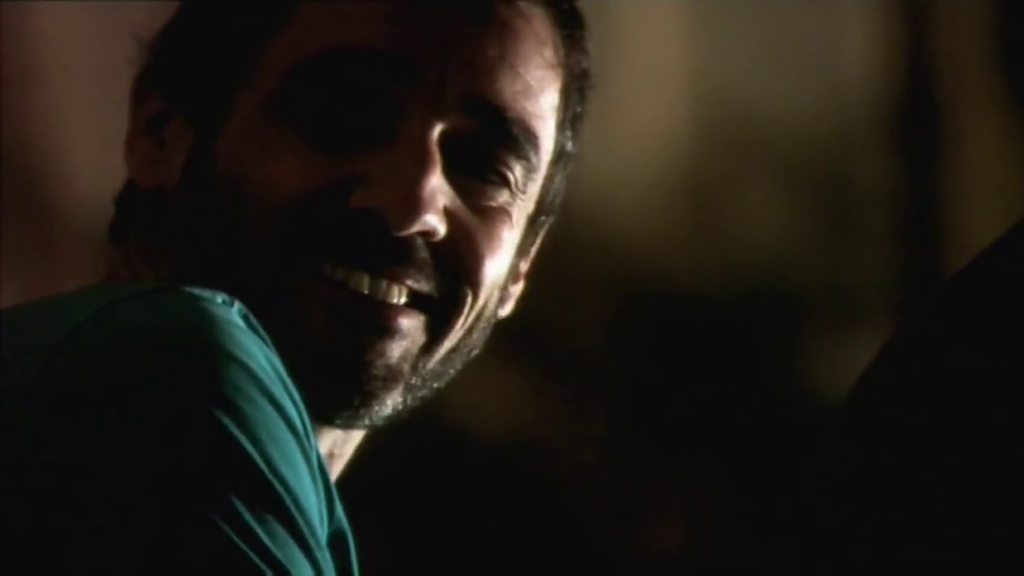
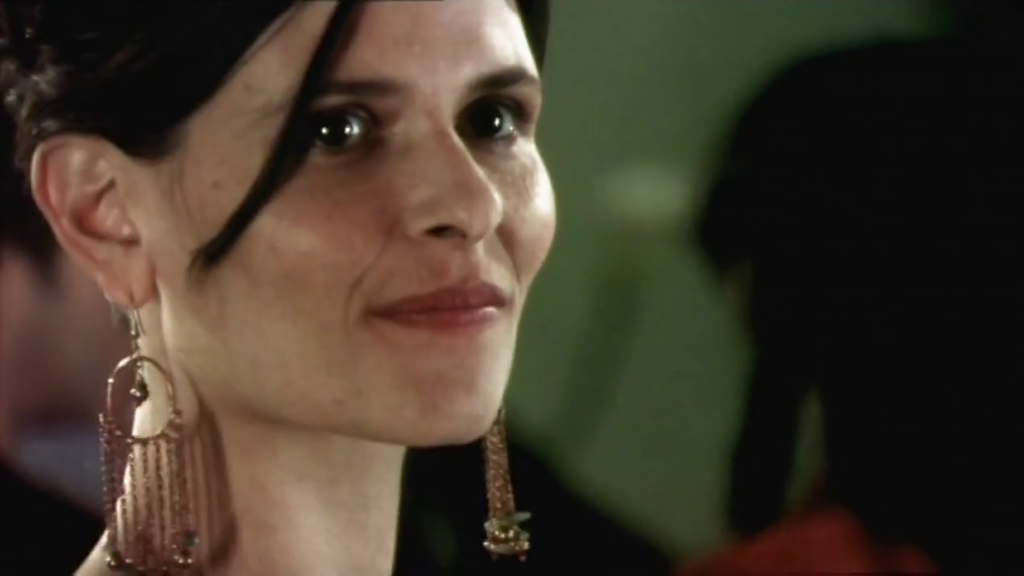
Figures 1 and 2: Visual pleasure in the I/eye of the Other. Gugliotta, Las vidas posibles/ Possible Lives, Argentina. 2006. Global Lens Collection.
Following the party, a sex scene not devoid of such ‘soft-core codes’ as Carla’s fishnet stockings and the muted grainy texture of her profile as her gaze glides over his well-shaped torso, create a formulaic treatment of idealized sex that will serve as a point of departure for narrative complications (Krzywinska 2006: 32). Those are to come in the morning, when Luciano silently leaves the apartment after giving his sleeping wife a tender look. When Carla wakes up to the bang of the wrought iron elevator doors, her disoriented and preoccupied attitude suggests that this exit may have been unexpected. Finding her way to the window and surveying the street for his car, a sense of deception sets in that sharpens the viewer’s perception of the connection between Luciano and his more rugged looking version in the three opening shots. Two versions of the seemingly same man become mysteriously linked and encode the narrative as an interrogative text. By the time Carla leaves Buenos Aires, her home has become uncannily unfamiliar as night noises of elevator and steps in the hallway haunt her irregular sleep. In the inhospitable environment of Patagonia where Luciano used to travel for his work and presumably disappeared, and where men in charge to find him aim to discourage her interference, Carla engages the spectator in her quest to know and control her object of desire, which she claims as soon as she lays eyes on him shortly after her arrival. Luís, a real estate agent and married, shows no sign of recognizing Carla, thus confounding the spectator but seemingly not her. While the double problematizes vision and causes a split in the self-image of a male protagonist in the traditional fantastic text, it serves Carla’s goal to ‘rediscover a unity of self and other’ (Jackson 1981: 51-52), and to heal from the alienating loss of Luciano.
Following the Lacanian argument that throughout life, ‘subjects constantly reconstitute their identities within a synchronic, cultural signifying context – a Symbolic order – to secure themselves a fixed value in terms of their Imaginary “self-fables”,’ the cinematic techniques in Las vidas posibles serve the representation of a feminine subject striving to recover imaginary coherence in the spectral field of the Other (Ragland-Sullivan 1986: 223). During a first meeting with the pretext to view a house on sale, Carla engages with Luís on his terms, as strangers just getting to know each other. The montage of the encounter communicates sexual tension as they circle through the rooms as in a game of hide and seek. Simultaneously, the stylistic elements of light, extra-diegetic sound and the movement of the characters operate together to heighten Luís’ alluring effect on Carla. The paleness of her face intensifies with the volume of an electronica soundtrack that signals increased attention for the spectator as bright light from a window bathes the figure of Luís, and Carla succumbs to a fainting spell. A touch on her forehead awakens her as Luís pronounces her name. While the scene exemplifies a display of feminine passivity, it also allows Carla to manipulate the situation and engage Luís on a more intimate level. Moreover, the close-up of her opening eyes, responding to his concerned look, replicates a Mirror Stage scenario of self-identification in the gaze of the Other. Luís thus comes to replace Luciano in Carla’s self-fable as she explains later: ‘My husband recently died, and I am not well yet,’ only to correct herself, ‘I meant to say that my husband has died for me’.[2] The difference between the two sentences signals a transition in Carla’s self-image from one as bearer of a lack that requires healing to one of agency in redefining her position. Filtered through the lens of the fantastic, Luís becomes the object of Carla’s obsessive inquiring look. The conventional eye-line match during their short conversations often changes to a focus on his profile and cutaways that follow his gaze drifting out of frame, thus intensifying the enigma of his identity. At the heart of the narrative, the identity of Luís, as the object of Carla’s gaze, provokes the most intense scrutiny as the narrative reveals the I/eye as an ambiguous source of knowledge but also as the instrument of a feminine mobilized gaze and an active spectator position.
Carla’s reclusive and secretive search offers few point-of-view and shot/reverse-shots to measure the opinion of her interlocutors in the following days. Short conversations with the official investigator and the hotel owner portray the men’s assumption that Carla may not have known everything about her husband. Within this structure of masculine versus feminine access to information, Carla stalks, spies and searches for recognition by Luís, while a bewildering array of temporal displacements in the story line complicate a cause and effect-based viewing position. Appearances of Luís, often with his wife Marcia, resist identification as flashbacks or flash-forwards as Carla pursues these manifestations relentlessly. Her view of scenes from Luís’ life with his wife appear through rapid cutting as she stalks the couple, gazing into their windows and following them in the car. Cross-cutting through time and place, these short sequences, some of them in repetition, intrude into Carla’s field of vision and resist placement into a chronological story line for the spectator. Snippets of the couple’s conversations bleed into Carla’s consciousness in front of the mirror as she brushes her teeth. The immediately following match cut that shows Carla spying into the couple’s cabin does not provide a temporal context and instead conforms to Jackson’s description of the fantastic theme of dislocation when ‘[i]deas become visible, palpable, so that mind and body, mind and matter merge together’ (1981: 50). Carla’s vision and senses are flooded by strands of narrative sequences in which Luís and Marcia appear to prepare for a hasty departure from their house or in a conversation that leaves Marcia saddened or dejected. These rivaling narratives from Luís’ life undermine a static and passive viewing position as the spectator vacillates between possible interpretations. Paired with an uncanny sense of unease which the film maintains with an eerie soundtrack, high or low angle shots of Carla build suspense when she retreats to her room while the hotel owner watches her with consternation. As part of a sense of alienation and distancing, sensory input and editing alternately orient and disorient the spectator and result in an awareness of the framing of each shot as well as the off-screen space. Resulting in a productive viewing process rather than a static spectator position, color-coded scenes in which Carla either wears bluish-gray, red or white sweaters offer new clues but turn out to be false indicators of location or time. Instead, they hint at emotional dimensions such as the dark red walls of Carla’s hotel room that had been reserved for Luciano. As a marker for passion, red increasingly is the color she wears during her sexual encounters with Luís.
Carla meets with Luís in uninhabited houses as she pretends to purchase one in particular. Their time together in a closed-off attic room however remains sealed from narrative flow. Carla’s probing and desiring gaze tries to reclaim Luciano and her frenzied touch retraces bodily features she seems to recognize. Luís’ response is one of complying tenderness, yet after lovemaking, his melancholic gaze points towards an undisclosed space in the distance. This hermetic aspect of Carla’s love object matches his function as a one-dimensional foil or double of Luciano, a stand-in for an absence that Carla refuses to accept. Instead, she takes up a double life that she hides from the few people around her, even her sister who has arrived at the scene. Although it is impossible to ascertain her influence on Luís’ life or to understand his situation beyond Carla’s perspective, the suspicion that Carla and Marcia share the same man in parallel stories engage the spectator in untangling narrative threads that touch and intersect, contaminating one reality with another. A short conversation between the two women in a café by a lake, where Marcia works, does not reveal any confidentialities beyond Marcia’s remark about ‘the malaise of the South’, an affliction of the mood caused by the lack of light during the winter months. Whether referring to a threatening malady for those who live here too long, or a warning to Carla, this cryptic comment associates with Marcia’s desolate state in the opening scenes. Thus, the elliptic sequences that narrate Luís’s leave-taking from Marcia come into focus again when the thawing of the lake allows the recovery of a car.
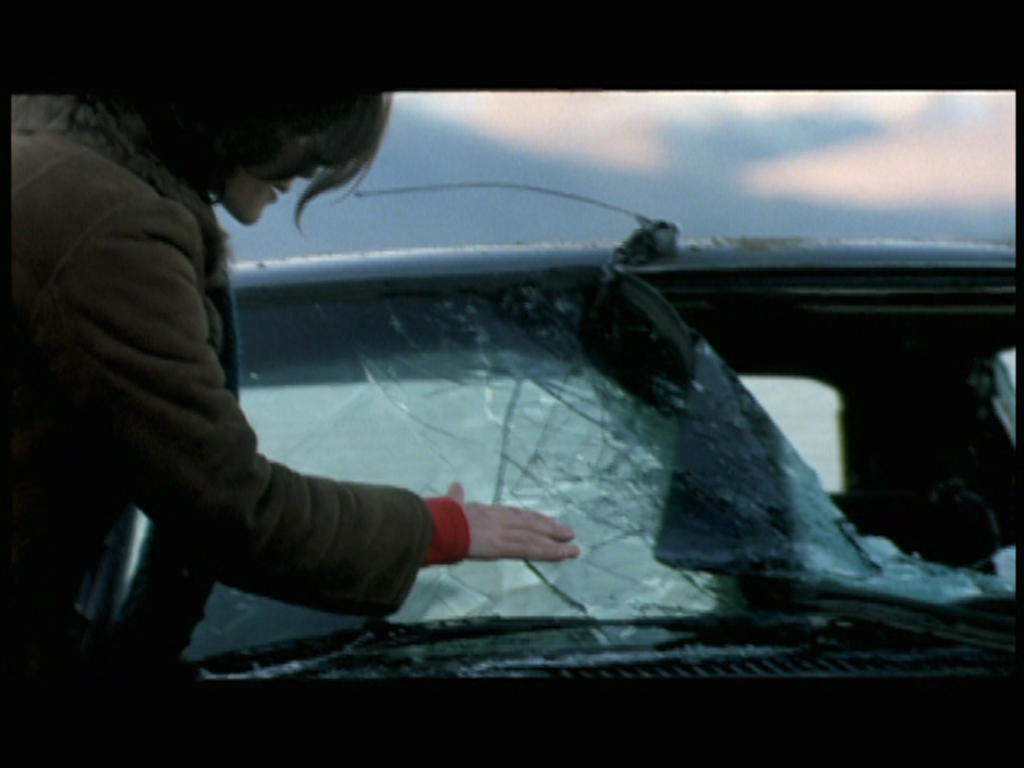

Figures 3 and 4: Converging scenes from Marcia and Luís’ lives are coming into context. Las vidas posibles.
Carla receives notice to identify a body after returning from lovemaking with Luís. She prepares for the morgue hastily, putting on lipstick, rouge and a deep-cut reddish dress like an armor of sensuality. The display of her sexual attractiveness clashes with the cold formality of the morgue, defining a duel between life and death. With her refusal to identify the corpse as that of her husband, Carla seizes the power to ‘look, to see, to define, to control, to make reality, however unacceptable, mad or irrational that might appear from the male way of looking’ (Jackson, 1989: xxvi). When she admonishes her sister who is also present, ‘[d]on’t you remember Luciano’s face?’ she is pitting the spectator who cannot see the corpse between two perspectives for a little while longer. Carla’s conviction of having reclaimed Luciano as Luís comes under attack with a replay of scenes that before had been out of context but offer another view and interpretation. Luís’ brisk departure from his house with a duffle bag and raincoat once more inserts itself into the main story as competing temporalities slide into each other. A sense of urgency accompanies these unraveling narratives as the final scenes head towards a choreographed converging of the two male characters. Luís, after reaching the lake and hoisting the sails of his restored boat, slowly glides away against the backdrop of icy glaciers while Marcia watches sadly from the boardwalk. A cut to Carla, also at the bank of the lake, finds her tracing the cracks on the windowpanes of the salvaged car with her finger, and then breaking down to cry. Looking up for a moment, not particularly aware of the slowly receding boat, she begins a journey of grieving with the acceptance of Luciano’s death. The fantastic doubling of his character as Luís resolves into a metaphor for a process of mourning for Carla, and a transition from trauma and denial to a final forgiving acceptance.
There is however another story, to be told from Marcia’s perspective who also sheds tears as she watches her husband disappear in the distance. The unresolved mystery of their mission together and their separation haunts the film and inspires questions about Marcia’s loneliness and grief that so prominently imprints the film with sequences that not only undermine the chronological timeline of Carla’s personal tragedy, but also signal shifty yet persistent memories of the unsolved traumas of others. They justify the question of the social function of the fantastic in relation to Argentina’s history and its use as a tool for translating time, and its ‘capacity to point outside temporal normativity, to intimate the breakdown of chronological historical time’ (Cua Lim 2009: 31, 112). In this way, the use of the double in parallel and intertwined narratives in Las vidas posibles, apart from its symbolic representation of the grieving process, also harkens back to the national trauma of the disappeared and the untold stories of resistance that inhabit the national psyche. As Carla reanimates her dead husband in the image of Luís with the power of her gaze, the film activates patterns of remembering and mourning, perhaps of a collective past, thus substantiating ‘the very existence of experiences otherwise only fleetingly and troublingly maintained as elusive memories’ (Blessing and Trotman 2010: 11).
Azul’s story in Martínez Vignatti’s directorial debut, La marea, is one of devastating loss by being cast out of her life and identity as a wife and mother. Like Carla, she responds to her extreme state of sorrow by fleeing from her urban existence to Patagonia. The natural surroundings and the dominant force of the wind are the principal players in the mise en scène of this film, setting off Azul’s determination to carry out her daily chores to survive. Carrying water in a large canister on her back from a reservoir to her cabin or making firewood with a primitive ax in the nearby woods are actions she seems to complete instinctively, although she is less successful in ingesting the food she has brought along and routinely prepares but then has to push away. With minimal plot and dialogue, it is when Azul’s and the camera’s gaze are summoned by the appearance of the impossible, that the film steps into the realm of the fantastic as an extension of her interior life and the natural elements surrounding her. In contrast to the characteristic effect of surprise, disorientation or disbelief for the spectator, the appearances of Azul’s dead husband and son seem to bestow moments of comfort and hope on her struggle with trauma and mourning. Azul’s pain of losing her child provokes a crisis of identity and motherhood that comes close to an annihilation of selfhood. Her daily challenges for survival on an elementary physical level mirror the interior quest for a reason to go on living. In this film, like in Las vidas posibles, the feminine gaze is one of desire for confirmation in the eyes of a beloved Other, dramatizing the mechanism of Mirror Stage identification. However, Azul’s drama of finding herself as a mother without a child reverses the process. While it is the mother that in her image of completeness first establishes a link to the exterior world for the infant, the fantastic appearance of Azul’s son and his gaze upon her provide temporary relief from psychological disintegration. In this respect, La marea explores the intimate link between motherhood and a mother’s way of seeing herself, expanding thus the concept of the feminine gaze which the film addresses with the first establishing shot.
We meet Azul first in a shot staged like a portrait, though in contrast to a still, her hair is slightly moving. The image is ambiguous as a portrayal of her gaze at the camera. It invites to be seen as a self-referential gesture in acknowledgement of the camera, and on the psychoanalytic level, as a signifier for the imaginary completeness bestowed on the self during the entrance into the visual domain of subjectivity, the ‘cultural image-repertoire’ of ‘gaze, look, and screen’ (Silverman 1996: 3). Azul’s image shows how she is culturally apprehended and her returning look in recognition of her representation indicates an alignment with her assigned subject position. Her lively gaze blends with the luminous quality of her bodily contours as the white of her blouse blends seamlessly with the white background of what would be a screen or movie panel. Drawing attention to the artifice in this image, the shot accentuates an emblematic quality and an authorial gesture by the director. It will linger on like an afterimage and a point of reference to accompany the final shot of Azul’s look at the camera that closes the film.
Embedded in the opening credits, Azul’s introduction is matched by a second opening shot that captures the tide rolling in. In perpetual motion and with infinite regularity yet intriguing complexity, it is the antithesis of the cultural manifestations in the preceding shot and provides a representative image for the film’s title and by extension, the sea as the second protagonist, its majestic beauty emphasized by the soundtrack of the Adagietto movement of Gustav Mahler’s Fifth Symphony. As an extra-diegetic addition to the image, the orchestral composition accompanies the pronounced, long duration of the take (1.8 min.) and beckons attention to the paradox of the constant change and simultaneous continuity of the tidal waves. Nature, as principal player in the mise en scène, rivals Azul’s determination to carry on with her life in the isolation of Patagonia. The chronological structure of the narrative marks the passage of time and the hardship on her body.

Figure 5: Extremely long takes highlight the camera’s look as a self-referential gesture and as tool to present the psychological structures of identity. (La marea/ The Tide, 2007, Argentina, Belgium. Entre Chien et Loup. Martínez Vignatti)
With a fade-out of the tide, the narrative starts abruptly with an accident scene and a view through a broken car windshield. A woman on the passenger seat regains consciousness, touches her shoulder and laboriously turns to the slumped-over driver and to the back seat. A cut then hides the view as the camera recedes to a long shot accompanied by a shout from a by-stander who noticed the presence of a child in the car. The sequence ends with the arrival of an ambulance and elliptic fragments narrate in shorthand the events following the accident. A therapist massaging her bruised shoulder, Azul stroking the hair of her son in a hospital bed and the medical staff rolling the bed away, leaving the mother behind who breaks into tears. As she waits to hear from the surgeons, she stands framed by the blue tiles of the hallway where she collapses. Back in her home, she ignores her sister’s voice on the answering machine, and after collecting her backpack, deserts the house. A tracking shot of the bus in which she travels is accompanied by a female voice singing a song:
In the country I do not remember, I take three little steps and I get lost.
One little step to over there, I don’t remember if I took it.
A little step towards here, oh, how it frightens me.
In the country I do not remember, I take three little steps and I get lost.
One little step backwards, and I won’t take another one,
because I already forgot where I put my other foot.
This Argentine children’s song describes a crisis of identity and thus also Azul’s shock in losing her family, her purpose and direction. The words also reference a scene in the Oscar winning Argentine film, La historia oficial/The Official Story (Puenzo, 1985), which brought international attention to the Dirty War and its legacy of terror. In this film the song is a child’s expression of anxiety as her adoptive mother is discovering that she is the daughter of a young couple that was disappeared. Framing Azul’s personal tragedy of having been orphaned too, her desolate grieving perhaps echoes that of the mothers, wives and grandmothers without resort to finding their missing family members.
As Azul takes the steps to reach a cabin owned by her family in Patagonia, she crosses a terrain of wilderness to get to the ocean. Profile- and over-the-shoulder shots and tracking shots follow her in great detail as she walks, immersed in the sounds of the natural forces around her. On arrival at the cabin at night and after getting a fire going, Azul retrieves a box and studies intently a collection of photos, perhaps from times spent here as a child or with her husband and son. She remains sleepless during a gusty night and finally falls into a slumber at dawn. Azul’s journey and arrival at the dark cabin indicate an unsettled in-between state of awareness, but the fantastic appearance of her husband with his son by the hand is all the more unexpected as it happens in the bright morning light that awakens her. While for her, the spectral visitors standing at the threshold of the door may be deeply comforting – she falls back asleep after looking at them – the constant rattling and knocking of the wind around the cabin and the swaying key chain at the door produce a multi-sensory alertness for the spectator.
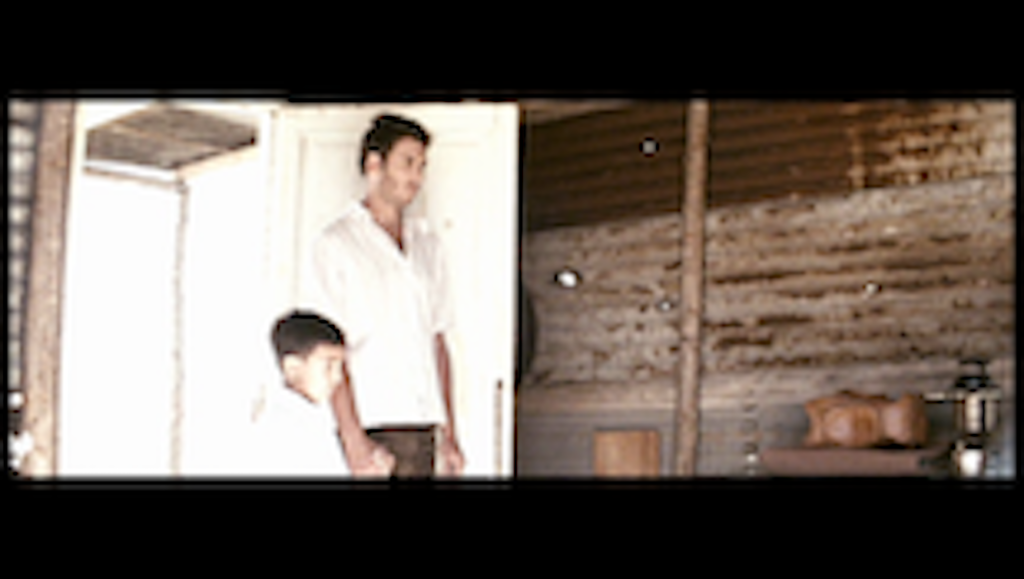
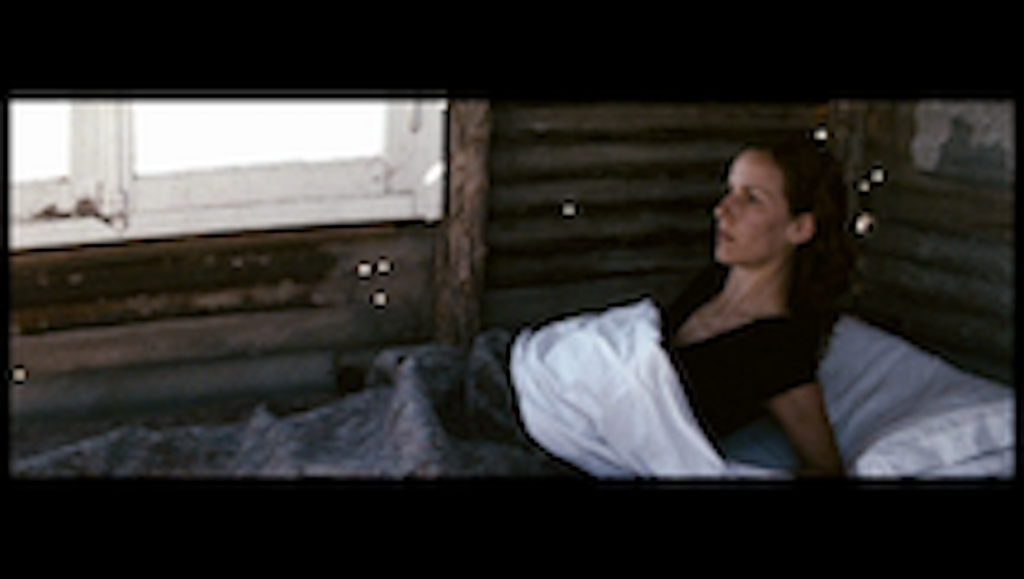
Figures 6 and 7: The fantastic in the feminine gaze as a source of comfort. La marea.
Getting no further clue from the sleeping protagonist, the camera’s eye falls on the closed door that suddenly flies open again, but it is only a young man who quickly grabs some gear from the table. Later that day, on her trek to fetch water from a cistern, a horseman catches up with Azul and tells her that the small community here had assumed that she was dead. While Azul continues her labored climb over the dunes, the remark signals a symbolic dimension of her struggle as a grieving survivor.
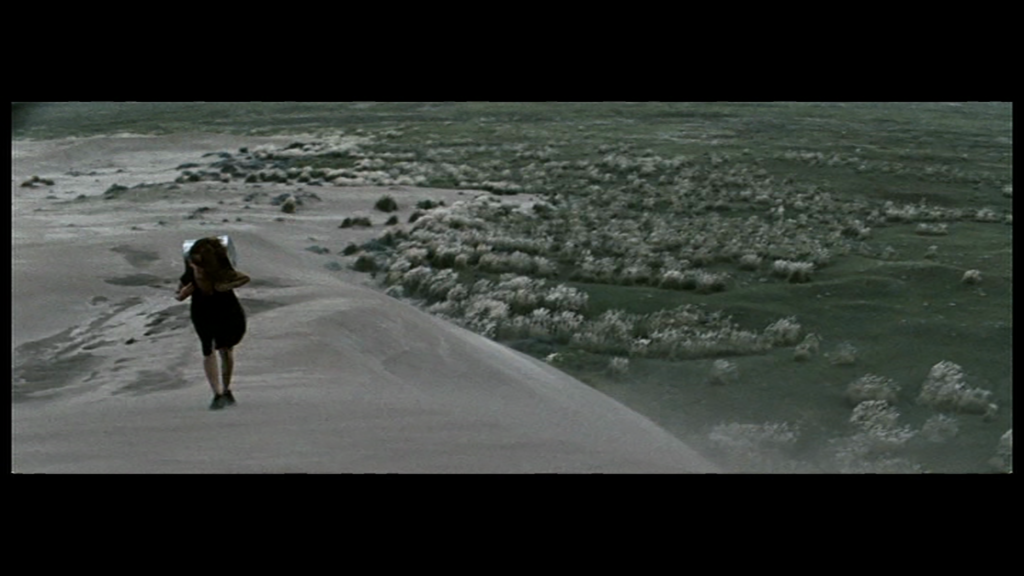
Figure 8: Azul in her struggle with the elements. La marea.
The days are marked by her laborious routine and decreasing strength, whereas her fitful sleep at night replays a dream sequence, triggered by the chore of chopping firewood, in which she spots her child in between the trees. The spectator participates in the pursuit through quickly changing camera angles that conflate vision with the sound of the disorienting rustling of the leaves as the child joyfully leads his mother deeper into the woods. The growling of an animal hastens Azul’s steps, quick enough to come to her son’s side and scare away a puma facing him. The dream breaks off here, but the discovery of a gravely wounded dog the following day focuses her protective spirit, as she carries, exhausting all her strength, the large animal to the village veterinarian. The doctor’s identification of the wound as one inflicted by a puma reconnects her dreamworld with reality. A final appearance of her husband and child at the fire she builds at night however does not get much of Azul’s attention anymore. She takes note of their presence but seems to understand the finality of her bereavement and focuses on the flames. For a moment, she escapes her self-absorption to take notice of the young fisherman’s fire close by. With time, the dog recovers and becomes Azul’s companion, and the fish left for Azul by the fisherman becomes a source of food for the dog.
More and more attuned to the passage of time, the camera traces Azul’s long laboring walks through wind and sand, and her emaciated figure that is barely able to complete her chores. Long gliding tracking shots pan the dunes and the coastline over and over, as if sensing Azul’s fear of possible intruders, such as her sister who knows where to find her. Azul’s gaze, though fixed on the ground by the shore while she works sand and shells compulsively with her hand, once in a while lifts to survey the waves, as if feeling their encroaching presence. At one of these moments, with the weight of the water canister on her back, she faints and collapses into the oncoming tide with her dog trying to arouse her. It is the fisherman who comes to the rescue, carrying her to the cabin where he watches over her. When Azul awakens and accepts a sip of water, she clings to him, imploring repeatedly, ‘a son’. Her embrace however fades out to a white screen that only reconnects with her after an extremely long ellipsis that leaves room for the idea of a possible but unlikely sexual embrace. Eating with gusto in the next sequence, she is determined to bear a child in this natural solitude, telling her plans to her sister who arrives with bread and cheese which Azul devours, mostly wordlessly, waiting for her to leave.
Azul’s expressions of new hope and purpose – washing her hair, humming, smiling to herself and caressing the dog – contrast with the fleeting vistas of her surroundings that appear faint and drained of color. Her laborious steps and breath, joined by the ambient voices of wind and sea, describe an increasingly hopeless struggle against the force of the elements. At night her gaze into the fire triggers another dream sequence with her small son, but this time in a forest that has burnt down. In pursuit of the child, the scene synchronizes Azul’s repeated calls, ‘[s]on!’ as the camera switches focus on desolate tree stumps, creating a dialogue between her panicked search and despair. A premonition of her final bereavement secretes into the atmosphere as Azul faces a vision of a couple with a small son, accompanied by the tune of a bandoneon. Walking towards her at the beach and then passing, oblivious of her presence, the hazy, shimmering image and the haunting extradiegetic sound present the viewer with Azul’s perception of its harsh message, the loss of her own family and her unimportance. Not much later, the discovery that she has menstruated dashes her hope for a child and precipitates her actions towards defeat. In rapid sequence, Azul walks towards the approaching waves until they reach shoulder height when she turns to look at the camera with a distorted expression, perhaps of despair. The film ends with this image as a still, entrusting the spectator with Azul’s uncertain fate. The freeze frame of this provocative moment galvanizes her social isolation like a call for partaking in her tragedy and refers back to the confident half-smile from the opening credits. As in a palimpsest, the two images inform each other and ‘evoke the gap in time’ between one and the other (Mulvey 2019: 143). The trope of two overlapping images of Azul’s gaze draws attention to the structure of the human self which constitutes itself in the seeing/being seen opposition, that is, the gaze of another being.
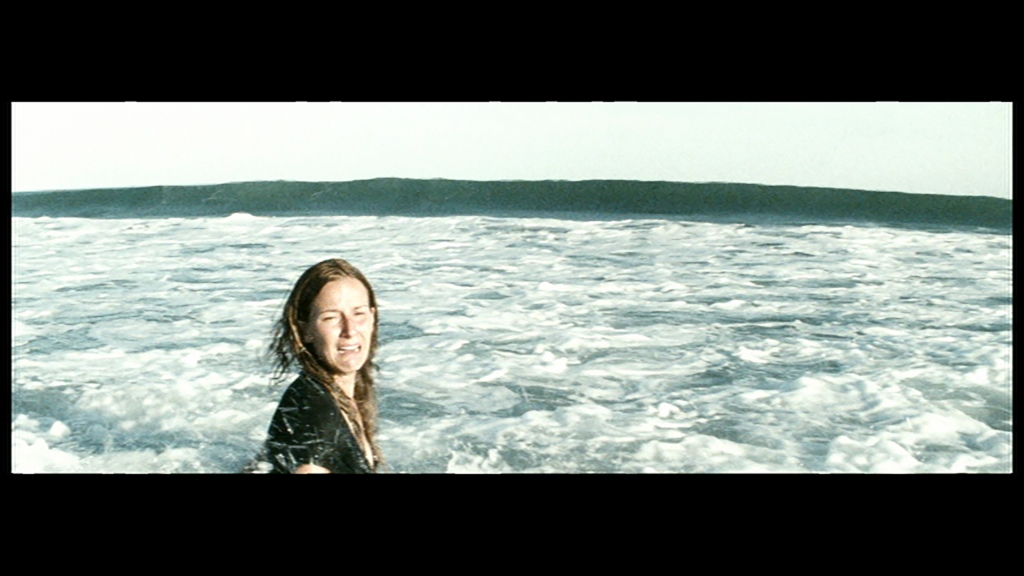
Figure 9: The last shot of Azul turns into a still. La marea.
Like Carla, Azul is a character inscribed in the constrains of a patriarchal order that informs her sense of self-worth and social identifications as well as the unconscious processes that structure subjectivity. Through dreams and ghostly apparitions, the fantastic becomes part of a filmic practice that explores the dialogic nature of the gaze as the feminine subject undergoes the trauma of an orphaned motherhood. In Las vidas posibles, fantastic doubling or haunting emerges in the interstices of the linear plot as a feminine desirous gaze duplicates and fragments plot lines to access an ‘unconscious time’ and memories that otherwise do not pass for normative reality (Silverman 1996: 3). Through borrowed memories, a representational practice such as film, provides access ‘psychically to pains, pleasures, and struggles which are far removed not only from our own, but from what normative representation validates’ (Silverman 1996: 4). The filmmakers of Las vidas posibles and La marea harness the disruptive force of the fantastic through a feminine gaze, which becomes an enabling structure to see beyond the limitations of dominant signifying systems and values. Hence the ghosts of post-memories of the Dirty War still haunt these films too.
References
Blessing, J. and Trotman, N. (curators) (2010), ‘Introduction’, in Haunted: Contemporary Photograph/Video/Performance, New York: Guggenheim Museum, pp. 11-13.
Cua-Lim, B. (2009), Translating Time: Cinema, the Fantastic, and Temporal Critique, Durham: Duke UP.
.De Lauretis, T., (1984), Alice Doesn’t: Feminism, Semiotics, Cinema, Bloomington: Indiana UP.
Doane, M.A., Melloncamp, P. and Williams, L. (eds) (1984), ‘Introduction’, in Re-Vision:
Essays in Feminist Film Criticism, Los Angeles: U Publications of America, pp. 1-17.
Freud, S. (1976), ‘Appendix: The “Uncanny” (1919)’, New Literary History: A Journal of Theory and Interpretation, 7:3, pp. 619-45.
Gledhill, C., (1994), ‘Image and Voice: Approaches to Marxist-Feminist Film Criticism’, in Carson, D., Dittmar, L., and Welsh J. R. (eds), Multiple Voices in Feminist Film Criticism, Minneapolis: U of Minnesota P, pp. 109-123.
Gugliotta, S. ([2006] 2007), Las vidas posibles/ Possible Lives, Argentina: Global Lens Collection.
Hansen, M. (1997), ‘Early Cinema, Late Cinema: Transformations of the Public Sphere’, in L. Williams (ed.), Viewing Positions: Ways of Seeing Film, News Brunswick, NJ: Rutgers UP, pp. 134-152.
Jackson, R. (1981), Fantasy: The Literature of Subversion, London: Methuen.
____ .(1989), ‘Introduction’, in J.A. Salmonson (ed.), What did Miss Arrington See? An Anthology of Feminist Supernatural Fiction, New York: The Feminist Press at the City, U of New York, pp. xv-xxxv.
Krzywinska, T. (2006), Sex and the Cinema, London: Wallflower Press.
Martínez Vignatti, D. (2007), La marea, Belgium: Sébastien Delloye, Entre Chien et
Loup.
Mulvey, L. (1975), ‘Visual Pleasure and Narrative Cinema’, Screen,16:3, pp. 6-18.
_______. (2019), Afterimages: On Cinema, Women and Changing Times, London: Reaktion
Books.
Oubiña, D. (2007), Estudio crítico sobre La Ciénaga. Buenos Aires: Picnic Editorial.
Puenzo, L. ([1985] 2003), La historia oficial/The Official Story, Argentina, US: Koch Lorber.
Ragland-Sullivan, E. (1986), Jacques Lacan and the Philosophy of Psychoanalysis, Chicago: U of Illinois P.
Silverman, K. (1996), The Threshold of the Visible World, New York: Routledge.
Todorov, T. (1973), The Fantastic: A Structural Approach to a Literary Genre, (trans. R. Howard), Cleveland: The Press of Case Western Reserve University.
Williams, L. (1997), ‘Introduction’, in Viewing Positions: Ways of Seeing Film, Rutgers UP, 1-20.
[1] Freud discusses this gothic concept of the double in German Romanticism in his study on the uncanny or ‘Das Unheimliche’ (1919)”.
[2] All translations, unless otherwise specified, are mine.






